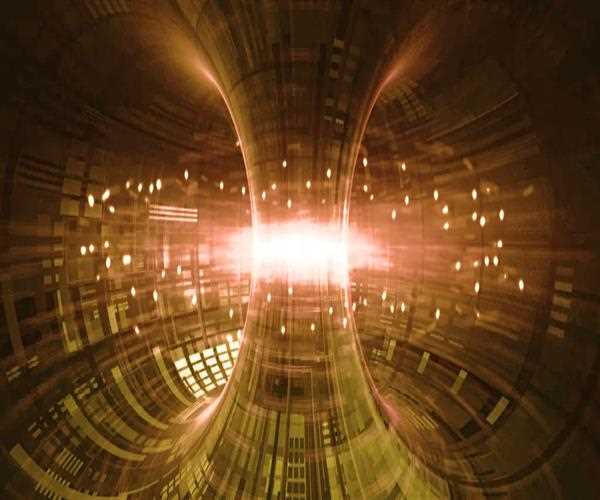Search here

03-Apr-2024 , Updated on 4/5/2024 7:28:09 AM
Artificial Sun 'Korean Fusion Reactor' can replace the natural Sun. Is that true?
Scientist in the whole world are continuously trying to find renewable, sustainable, eco-friendly energy resources so that the future can be greener and safer. They always wanted to develop something that can work like sun. But the heat from the sun is result of nuclear fusion and that is very hard to achieve on earth.
But there has been a big step in this process which was from South Korea's Korea Superconducting Tokamak Advanced Research (KSTAR) device which is popularly known as an "artificial Sun" nuclear fusion reactor. We will now explore how this exciting new technology is the bright future and many people believe that instead of using the Sun to give us energy, this technology would be used for that.
Understanding Nuclear Fusion
Nuclear fusion takes place through the merging of two atoms which leads to a tremendous amount of energy. These are what the Sun uses to generate energy and also can provide limitless clean power without any of those greenhouse-gas shielding pollutants. The difficulties consist of how to reproduce the same effect down on Earth in a laboratory. Like the KSTAR fusion reactor, this technology tries to simulate the in-star core conditions of high temperatures (millions of degrees Celsius) and isotopes of hydrogen fuse to give off energy.
KSTAR: The "Artificial Sun"
The KSTAR, the Korean Fusion Reactor, is now the symbol of fusion research, experimenting with the possible ways to unlock the fusion power. An important record of this design was when it achieved its goal of having the plasma heated to 100 million degrees Celsius for 48 seconds in a row. This is one step along the way to making fusion energy practical and clean.
The reactor, within the torus-shaped vessel, called a tokamak, utilizes magnetic fields that are extremely powerful to control and confine the super-heat plasma, which imitates the conditions of the ionized gas in the Sun's interior. KSTAR’s triumph showed how to achieve and sustain fusion by obtaining and maintaining the extreme temperatures needed to master fusion and thus, humanity can make fusion energy at home a reality.
Surpassing Previous Records
The significance of KSTAR’s accomplishment is not only about the record-breaking; it is overcoming of critical barriers in the path to fusion power. KSTAR generates and holds the plasma at seven times the temperature of the Sun's core, acting as proof of its ability to handle the very challenging conditions required for nuclear fusion. Extending the time for which plasma can be stable in the fusion reactor is the fundamental approach toward the mission of sustainable fusion power generation for practical use.
Tackling Technical Hurdles
This means that the key step to the success of KSTAR is the application of the tungsten divertors. They are the basis of a magic trick to keep up with the tremendous quantities of heat and waste products produced during the thermonuclear fusion reactions. The tungsten diverter in the KSTAR reactor instead of the previously used carbon-based diverter, offers higher durability and plasma fuel absorption resistance, making KSTAR performance time longer.
Paving the Road for ITER.
KSTAR is not only the first of its kind among the K-class tokamaks but also a solid basis for the International Thermonuclear Experimental Reactor (ITER), where scientists worldwide are jointly constructing the world's biggest tokamak fusion reactor. By proving, that the hydrogen plasma can be maintained in stable condition for a long period, KSTAR gives significant ideas and confidence to ITER developers in completing the plan of sustaining the fusion reaction for commercial units. The result of KSTAR experiments will be a source of data for ITER, hastening ITER the way of implementation of fusion reactions permanently and of a clear indication of fusion energy just like a power source for the whole future.
Towards Sustainable Fusion Energy
Whilst KSTAR stands as a mark of considerable improvement, it is needless to say that fusion energy is still far from being implemented practically. Scientists have a vision of a future where fusion reactors could maintain the plasma at critical temperatures for a long time, which could lead to commercialization of the fusion power and its widespread utilization, thus discovering its full potential. Addressing the yet identified challenges and improving the design of the fusion reactor at the same time, are going to be the subjects of more research and development.
The High Stakes of Limitless Clean Energy.
Fusion may be the answer to the search for a sustainable, clean, and limitless source of energy that will bring significant changes to the way we produce power. By applying the same process as the Sun, fusion reactors like KSTAR show us a road towards having a sustainable and thriving future. Unlike fossil fuels through fusion energy, no greenhouse gas emissions or radioactive waste are produced, which makes it a protective eco-friendly solution allowing us to manage climate change and lessen our reliance on run-out resources.

Student
An MBA in finance imparts and improves management aptitude, inventive ability, critical thinking ability, and so forth. It offers a real-time experience that fabricates a staunch career foundation for students and working professionals. It helps them to thoroughly understand the financial sector.
Comments
Join Our Newsletter
Subscribe to our newsletter to receive emails about new views posts, releases and updates.
Copyright 2010 - 2025 MindStick Software Pvt. Ltd. All Rights Reserved Privacy Policy | Terms & Conditions | Cookie Policy